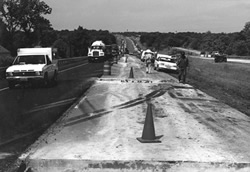U.S. Department of Transportation
Federal Highway Administration
1200 New Jersey Avenue, SE
Washington, DC 20590
202-366-4000
Focus
| Accelerating Infrastructure Innovations |
Publication Number: FHWA-RD-02-006
Date: January 2002
With an Interstate system that spans more than 67,000 Km (42,000 mi) and many thousands more miles of local and State roads from coast to coast, mobility is crucial to our country's well-being and quality of life. Whether it means being able to get to work, to take a family vacation, or to ship goods from one State to another, both citizens and businesses alike expect safe and reliable roads. A sound infrastructure is the backbone that provides this reliability.
A sound transportation infrastructure requires care and maintenance, however. The Federal Highway Administration's (FHWA) Office of Infrastructure is working with our partners in State and local highway agencies and industry to promote a range of initiatives aimed at enhancing our highway system, increasing safety, and reducing congestion. One key to a better system and reduced congestion is managing construction and maintenance work zones more effectively. As a growing portion of the State highway system reaches the end of its initial service life, work zones are a fact of life across the country. But all work zones are not created equal: Highway agencies are demonstrating that innovative practices can reduce the impact of road work. These practices include using temporary road closures to complete work faster, enhancing public information programs that encourage motorists to use alternate routes during construction, and using such innovative contracting practices as design-build, warranties, and incentives/disincentives to encourage better quality control and faster work. We know that our customers want us to "get in, get out, and stay out," and more highway agencies are accomplishing this task.
Mobility is crucial to our country's well-being and quality of life.
|
Even better than a well-managed work zone, however, is not needing a work zone at all. As an increasing number of highway agencies introduce longer lasting high-performance materials, less disruptive preservation and maintenance work will be required. Bridges that are being built with high-performance concrete (HPC), for example, are expected to last significantly longer than conventional bridges in certain environments. HPC is made using the same basic materials as conventional concrete, but the proportions and curing conditions are engineered to produce concrete mixes that meet the requirements of specific bridge projects and thus provide a more durable, higher-performing structure. The adoption of HPC is being aided by FHWA's Innovative Bridge Research and Construction Program, which provides funding to help State and local transportation agencies use innovative materials for bridge repair, rehabilitation, replacement, and construction.

|
|
|
Quality control and quality assurance programs also help to cut down on the time needed for maintenance and repairs. As more highway agencies embrace an asset management approach, which emphasizes the timely preservation, maintenance, and upgrading of highway assets through cost-effective planning and resource allocation decisions, an important byproduct is an increased focus on quality. Highway agencies are using pavement, bridge, and maintenance management systems, for example, to collect and monitor information on current conditions, forecast future conditions, and determine the best program of highway or bridge investments to pursue over a designated time period. The use of these systems will help agencies to maintain a steady level of performance and quality and optimize the use of limited highway resources.
A road's effective service life can also be extended through pavement preservation efforts, which involve the application of carefully selected surface treatments applied at the right time. The key is to apply the treatments when the pavement is still in relatively good condition, with no structural damage. It is estimated that the use of pavement preservation treatments can extend the life of a pavement by 5 to 7 years. Ultimately, the less repair work that needs to be done, the less congestion and traffic disruption our customers will have to face. In addition to pavement preservation efforts, the use of such newer technologies as HIPERPAV, the Superpave system, and stone matrix asphalt is also central to achieving more durable pavements.
Over the long term, FHWA's and our partners' efforts to enhance pavement and bridge performance, improve safety, and cut congestion will be bolstered by the work of the Transportation Research Board's Future Strategic Highway Research Program (F-SHRP). Research areas being considered for F-SHRP study include achieving rapid, long-lived reconstruction of highways with minimum disruption and reducing user delay. The F-SHRP efforts, combined with the ongoing State and Federal emphasis, will be important in ensuring that the Nation's infrastructure continues to provide the safety and reliability that is so vital to our daily life.